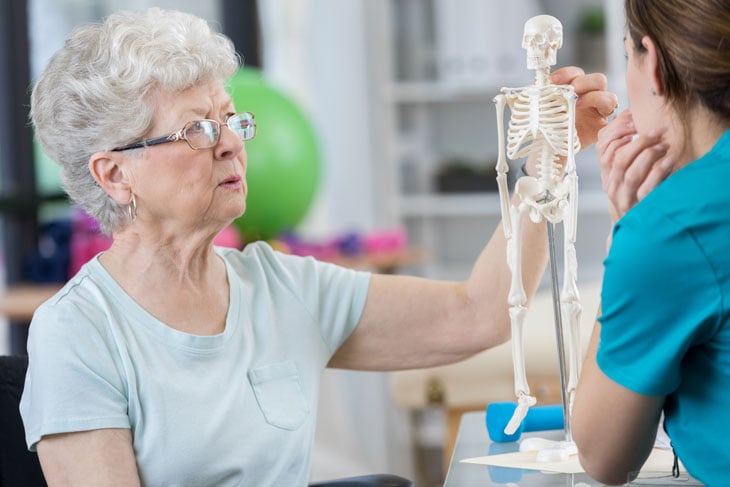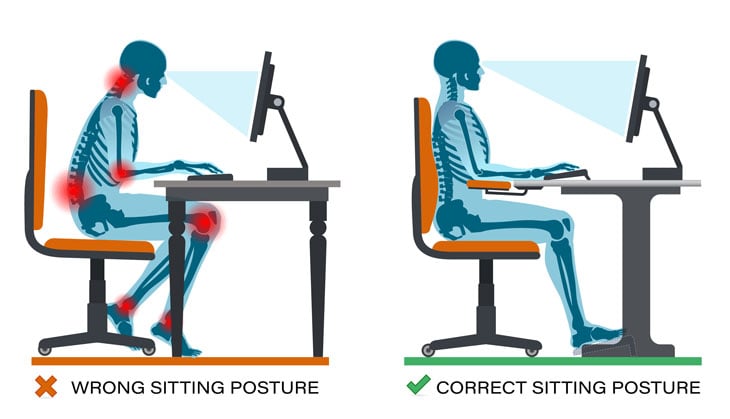Thrive Wellness: Strike the Right Balance with Proper Posture
Updated from the original publication on May 27, 2021.
A few months ago, in one of our Thrive Wellness blogs, we highlighted walking as a great way to engage in a simple, easy, healthy physical activity. Walk when you have time and enjoy it – walk inside, perhaps on a piece of exercise equipment, or head outdoors. When walking outside, one not only gains the benefits of the physical movement itself – but can also enjoy other key dimensions of wellness such as emotional, spiritual, and social. Walking is an activity that is beneficial for various reasons, but how a person walks is noteworthy, as well.
 When we walk, we should practice good posture to get the most out of our walks and to stay safe and maintain proper balance. Often people will lose balance and be more likely to fall while walking in part due to poor posture. May is “Correct Posture Month,” and our focus is on maintaining proper posture while walking, being seated, and also while lying down. If a person can correct their posture when necessary, be thoughtful and purposeful about working on it – it will go a long way towards improving their overall balance and mobility.
When we walk, we should practice good posture to get the most out of our walks and to stay safe and maintain proper balance. Often people will lose balance and be more likely to fall while walking in part due to poor posture. May is “Correct Posture Month,” and our focus is on maintaining proper posture while walking, being seated, and also while lying down. If a person can correct their posture when necessary, be thoughtful and purposeful about working on it – it will go a long way towards improving their overall balance and mobility.
So, what is posture? As defined by the American Chiropractic Association, “Posture is the position in which we hold our bodies while standing, sitting, or lying down. Healthy posture is the correct alignment of body parts supported by the right amount of muscle tension against gravity. Our everyday movements and activities can affect this alignment and put stress on joints and muscles, sometimes resulting in pain and potentially permanent damage if left unchecked over time.”
Posture is essential in all areas of life. Are we in proper position while seated, lying, standing and walking? Simply put, we must hold our bodies up using our muscles and core strength not to lose balance. Being in a state of proper alignment will also help our muscles, joints, and overall circulation. Think of it as having your center of mass (your body) over your base of support (your feet in contact with the ground) – when your body is aligned this way using proper posture – you will be in a position of good balance.
It is when our posture is poor that we get outside of this framework and can lose balance.
Regular physical exercise and activity are important to keep our muscles and joints conditioned. The American College of Sports Medicine highlights this in its position on Exercise and Physical Activity for Older Adults. “Additional benefits from regular exercise include improved bone health and, thus, reduction in risk for osteoporosis; improved postural stability, thereby reducing the risk of falling and associated injuries and fractures; and increased flexibility and range of motion.” Posture is important for maintaining proper balance, keeping one’s body aligned, and preventing undue stress on our muscles and joints.
When a person has poor posture, other parts of their body, especially their lower back, suffer. Hence, more physical issues are created by something that could have been prevented with improved posture.
Key tips for proper posture and body alignment while standing and walking:
- Stand up straight and tall, your lower jaw parallel to the floor/ground
- Do not round your shoulders; your shoulder blades should be brought back and kept somewhat down
- Align your body – ears over shoulders, shoulders over hips, and hips over knees and ankles. This sounds strange, yes – but stand up and try it. You will see that when purposefully engaging your body in this way – you are well aligned and in a position of good balance
- Consider you have a string on your belly button and can pull that inward slightly into your core. Everyone has a “six-pack,” yes you heard me right; everyone has a “six-pack” in their abdominals – you cannot always see it – but those muscles called Rectus Abdominus are there! Use those core muscles to ensure that your abdominals are engaged when standing, seated, and especially when walking. A person’s abdominal core muscles are the natural support structure for their spine. Engaging and using these muscles when moving takes undue pressure off of the spine.
- While seated, standing, or walking – try as much as possible to keep this alignment of your body. It will be challenging at first, but keep at it, and over time you will improve. As you improve – you will really feel the difference in your body, better balance, your muscles and joints will thank you, and your circulation will improve as well. When you combine all these elements with a good stride, you are off to a much healthier way to walk!
Follow these simple tips when seated as well, and you will feel a huge difference in your body. Making these conscious decisions to address posture will ensure proper balance and contribute to a much lower risk of falling when walking.
The following tips from the American Chiropractic Association are for maintaining proper posture while being seated and lying down:
While sitting at a desk:
- Keep your feet on the floor or on a footrest if they don’t reach the floor.
- Don’t cross your legs. Your ankles should be directly in front of your knees.
- Keep a small gap between the back of your knees and the front of your seat.
- Your knees should be at or below the level of your hips.
- Adjust the backrest of your chair to support your low- and mid-back or use a back support.
- Relax your shoulders and keep your forearms parallel to the ground.
- Avoid sitting in the same position for long periods of time. Take breaks and move your body.

When lying down in bed:
- Find the mattress that is right for you. While a firm mattress is generally recommended, some people find that softer mattresses reduce their back pain. Your individual comfort should guide your choice.
- Choose the right pillow, too. Special pillows are available to help with postural problems resulting from poor sleeping positions.
- Avoid sleeping on your stomach.
- Sleep on your side or back, which is often helpful for back pain. If you sleep on your side, place a pillow between your legs. If you sleep on your back, keep a pillow under your knees.
- Striking the right balance in our lives is very important in all aspects of who we are as people – deciding to address our posture will help our physical balance contribute to less chance of a fall and keep our bodies healthy and well.
Please stay tuned for next month’s post for Thrive Wellness updates and share this information with your friends. Invite them to subscribe to the PSL blog. Thrive Wellness monthly blogs will post at the end of each month.
People who come to Presbyterian Senior Living come for more than just a place to live– they come to feel energized, challenged, and fulfilled; they come to THRIVE.
About Presbyterian Senior Living
As the trusted leader in aging services, Presbyterian Senior Living combines over 97 years of experience with innovative approaches to senior communities and services. Across our 27 communities in PA, MD, OH, and DE, we serve over 6,000 seniors. We are committed to: FOSTERING teamwork and responsibility. UPHOLDING integrity in every action. EMBRACING innovation to create opportunities for everyone’s success. LEADING with compassion and respect.


